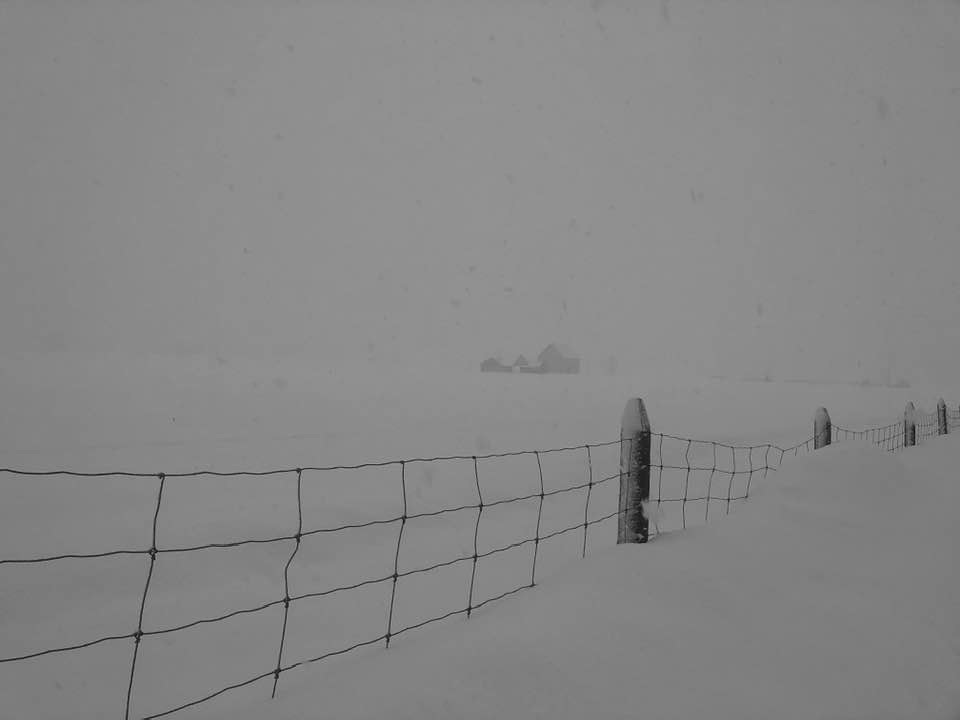I was driving back from my afternoon walk yesterday with Scoutie and all of a sudden the snow that had been lightly falling started to come down in a heavy blanket. I had decided that I was going to make a stop at the local bakery and so took my less travelled route, the one that led me alongside the Farm.
The falling snow was so thick that I could only see landmarks - like the trees here that embrace Morningside Lane. It is one of the farm roads that circulates through the fields that grow crops for scientific study in the summer months.
I have walked along these roads in the summer, a few times with Skye-dog before her spay many years ago, so that she wouldn’t be subjected to the indignity of another dog’s attentions. Few cars drive along here, as there is no efficient purpose to it, other than just to meander. When the fields are planted, either with soybeans, or corn, or anything else they are trialing, there are always signs telling people to “Stay out of the fields” — Lord knows what kinds of chemicals they might be using on these crops and the soil they grow in, either to keep them pest-free or to encourage stronger growth. Or maybe they simply don’t want passersby to abscond with the harvest…
The buildings here look ghostly in the distance and I imagine this is what it is like if you live on a farm, surrounded by your fields, in the middle of nowhere — not just in Canada, but in many countries where snow can envelope you. There must be such a feeling of solitude, the need for self-sufficiency and an ability to weather storms, storms like this one or storms of another kind.
It has made me think about how we are all weathering this storm that is the Covid-19 pandemic.
The feeling of having disappeared, of being invisible behind your mask, of living an enforced solitude. A melancholy.
Behind me, when I took these pictures, is the Rideau Canal. The canal is the waterway that connects Ottawa, the capital of Canada, to Lake Ontario, a distance of 202 kilometers (just over 125 miles). It begins where the Rideau River connects with the Ottawa River and moves south, through the city, with a number of locks to deal with the changes in elevation, and finally ends where Kingston sits on Lake Ontario. The construction of this waterway took place between 1826 and 1832, when Ottawa was called Bytown with a population of around 2000 people. We are able to get a glimpse into the conditions under which the workers toiled from John MacTaggart, a British Civil Engineer who traveled from England, specifically to lead the effort. Mr. MacTaggart wrote a two volume journal, if you will, detailing his oversight of this major work called Three Years in Canada: An Account of the Actual State of the Country in 1826-7-8 Comprehending its Resources, Productions, Improvements and Capabilities; and including Sketches of the State of Society, Advice to Emigrants, etc..* He explains (indeed, justifies from a management standpoint) how the workers had to be kept happy, warm, well-fed and watered, in this passage:
“Plenty of spirits and provisions of all sorts, with beds, blankets, mits, caps, shoes, etc., shall be always at hand, in the Government store, to answer whatever demands may come for such articles by the people on the work, so that every one may be kept strong, healthy and cheerful. There is a melancholy peculiar to Canada, which must be combated. People who labour under it must be encouraged with soothing language, good treatment, and now and then, as circumstances require, a little assistance, gratis, as a stimulant.”
The mention of Canada’s peculiar “melancholy” was what struck me, although I don’t know why. I’m sure the long, cold winters on forced hiatus from this relatively thankless project would be enough to make many Europeans wonder why they came at all…
About fifty five years after the canal was constructed, the Central Experimental Farm (just the “farm” as we call it) was born. It is, in reality, a four square kilometer agricultural government research centre in the heart of the city, but much of it resembles a park to its visitors, who embrace it as their very own beloved green space.
But here on this day, under the cloak of snow, the sky and horizon one, with lonely barns and windbreaks marking the ground, it struggles to be seen, as we all do during these pandemic days. But I saw it, stopped and took these pictures to show its beauty. It is seen.
Let’s encourage each other now, as MacTaggart encouraged his canal workers almost 200 years ago, with soothing language, good treatment, and a bottle of good wine. Cheers to better days ahead!
And, I see you, despite the storm.
* I am indebted to Rick Henderson and his blog entitled Capital Chronicles: the History You Were Never Told, specifically his entry from January 16, 2020, entitled “What’s Yer Poison?” The Hooch in the Valley for bringing this source to my eyeballs; his excellent historical blog can be found here: https://www.capitalchronicles.ca/post/what-s-yer-poison-the-hooch-in-the-valley?







